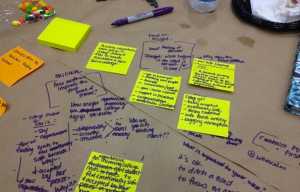 Somewhere hovering in the open rafters of a large design space at Mount Vernon Presbyterian School, the ghosts of my fictional protagonists from The Falconer, Mr. Usher and Sunny/Sun Tzu sat and had a cup of tea today. They don’t have Twitter accounts so we can’t follow their thoughts, but we know they listened with real attention to the explosion of learning at Day 2 of #Fuse13. Isn’t this what real learning looks like? Here are a few of the keys I picked up from the Twitter feed in just this one morning, from San Diego, in my easy chair:
Somewhere hovering in the open rafters of a large design space at Mount Vernon Presbyterian School, the ghosts of my fictional protagonists from The Falconer, Mr. Usher and Sunny/Sun Tzu sat and had a cup of tea today. They don’t have Twitter accounts so we can’t follow their thoughts, but we know they listened with real attention to the explosion of learning at Day 2 of #Fuse13. Isn’t this what real learning looks like? Here are a few of the keys I picked up from the Twitter feed in just this one morning, from San Diego, in my easy chair:
- Find better problems to help ask better questions.
- Shift from “What do I want” at the beginning of school to what do the students want.
- Sometimes process, not clarity, is the desired result.
- Widen options; reality-test assumptions; attain distance; be prepared to be wrong.
- Ask questions that truly provoke.
- Original questions lead to conventional solutions; provocative questions lead to innovative solutions.
- If you want more innovative solutions, find more interesting questions.
- “I am in a learning fog so thick I can’t see anything, and that is OK.”
- Best ideas are thoughtful recombinations of ideas.
- Brainstorming ideas comes AFTER we spend enough time finding and refining problems and AFTER we ask many questions, not before! This reverses how most people problem-solve and develop strategic plans.
- When you co-create you are both designer and user.
What can you take from this list into your classroom or school in the fall? How will learning shift away from the teacher/leader to empower the student/co-leader? Isn’t this a more important area for professional growth than learning the latest piece of cookbook software? Somehow, someway, we are going to expose thousands and thousands of teachers to what this kind of learning looks like. Just like kids, they will never want to go back in the box again.
The passion and energy from collaborative events like #Micon13 and #Fuse13 are real. They blow away traditional sit-and-get, just like messy, active, noisy, creative, self-owned classrooms blow away our assembly line model of learning.




Leave A Comment